Intern Takeover
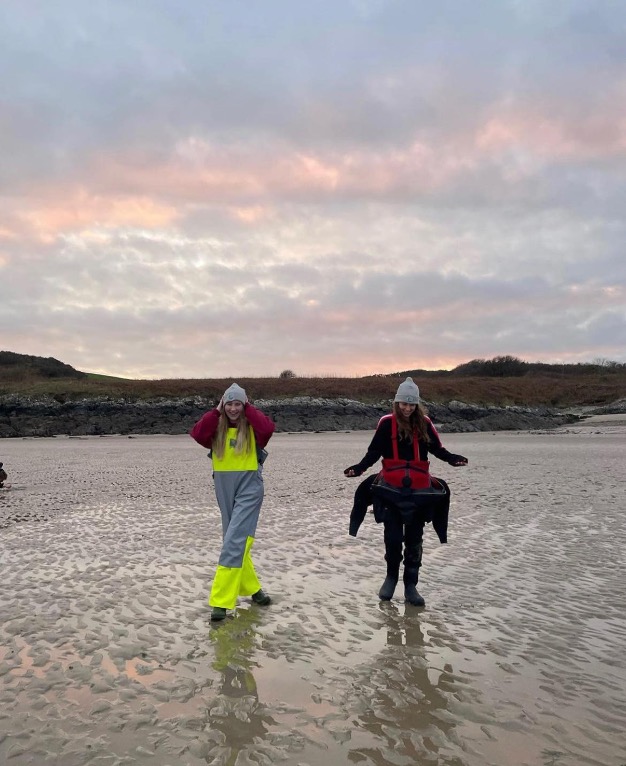
Intern Takeover – Planting trials in North Wales (February 2022) On Friday the 28th of January, a team of us started preparing for a week of fieldwork up in North Wales. A group of humans and one fluffy, four-legged companion (definitely the favourite member of Project Seagrass) helped fill 800 hessian bags and 200 coconut pots with sand and seagrass seeds. These were to be used in the experiments which lay ahead! Bertie looking very proud of himself after assisting the team with their very busy morning ensuring all of the seeds were prepped and ready for North Wales. The aim of this week was to help Lucy Coals with her PhD research project (a collaborative PhD with Deakin University, Swansea University and Project Seagrass), which is assessing how different site conditions and planting methods affect the success of seagrass germination and growth – how interesting, right?! This work is essential to help us better understand the conditions that seagrass prefers to grow in, including light and sedimentation preferences. Seagrass is very particular about its needs and is a very sensitive plant, so understanding the optimum conditions in which seagrass grows is SO important when considering things like site suitability for large-scale restoration efforts. After a very scenic 4-hour drive, filled with the most beautiful welsh landscapes and two of our incredible national parks – Brecon Beacons and Snowdonia, 9 of our team arrived at the Llŷn Peninsula in sunny but cold (nothing new there…) North Wales. Once we arrived and settled in, we tucked into some yummy pasta and headed to bed, making sure we were well rested to start our busy week of field work! Day 1: After a morning full of briefing, organising equipment and kit, we made the hour-long trip to Traeth Bychan in Anglesey to reach the mid-afternoon low tide. An accidental wrong turn led us to the longest named train station in the world “Llanfairpwllgwyngyllgogerychwyrndrobwllllantysiliogogogoch” – a mistake that we were NOT complaining about. Finally, we arrived and kitted up in waders and warm clothes, then headed down to the beach. Lucy demonstrated her 3 different planting methods – planting using hessian bags, coconut pots (which were slightly more exposed) and DIS (dispenser injection seeding) which mixes seeds with mud and is injected directly into the sediment. We then got started with the planting experiments and took sediment samples to assess the organic content and pollution of this site. After a busy first day we headed back to our accommodation, tired but in high spirits. There’s nothing quite like the feeling of completing the first day of fieldwork successfully after lots of stressful planning to ensure everything runs perfectly! Lucy demonstrating how she wanted her experiments, in what order the different planting methods were to be used and the specific way they were to be planted… as the rest of us listened veryyyyy well (check out all of the concentrating faces!) The longest train station in the world “Llanfairpwllgwyngyllgogerychwyrndrobwllllantysiliogogogoch” … go on… try and pronounce it, you know you want to! Day 2: We woke up feeling energised on Tuesday, with half the team deciding to head down to the local beach (Abersoch beach) for a cold-water morning dip. It was freezing and fantastic at the same time but what truly made it was the welcome that we received from the Abersoch dunkers group, who were not only the friendliest people on Earth but were also really interested in the work we were doing locally! Our completely crazy, bonkers team having a wonderful cold morning dip at Abersoch beach – surprisingly, we all felt AMAZING after this dip… maybe there’s a reason why cold water swims are hyped up so much… After another busy morning full of team briefings and preparing equipment and planting materials, we headed back up to gorgeous Anglesey. We split into two teams with half of us heading to Porth y Môr and the other half to Traeth Lligwy. Just like the day before we kitted up, walked to our site, set up the planting trials and took sediment samples when low tide hit – and that’s it! Another experiment set up and in full swing! Two sites down, another 2 to go! Due to the nature of the afternoon low tide, we experienced an amazing purpley pink sunset across the beach, lifting team spirit and moral – as the week went on, we were fortunate enough to keep being awarded with these mesmerising, colourful sunsets. The most beautiful sunset over Traeth Lligwy filled with purple and pink hues. It’s times like these that you take a few moments to appreciate the beauty of our stunning planet. GOOSEBUMPS! Day 3: We started the day with a quick GPS refresher from Lucy, after a quickfire of ‘what does this button do?’ we were put into teams to search for nearby GPS points – a lot of fun and a little bit trickier than it may sound… needless to say we all learnt a lot and are definitely a little more confident when using a GPS. Today we were heading to Penychain, where we spotted our first seagrass of the week – as you can imagine, the team of SEAGRASS ENTHUSIASTS were ecstatic with this discovery! A beautiful patch of Zostera marina on Penychain beach… I mean… does anything compare to the vivid green leaves of a seagrass plant?? I think not. Ben in his element. We also added these sightings to Seagrass Spotter – remember to add yours too if you come across a patch of seagrass!! When low tide hit, we got started on the experiments as normal but also did a site assessment – looking at the features of the beach like how much oxygen is in the sediment, what type of sediment was at the site (e.g muddy, sandy, gravelly), any signs of pollution (e.g runoff) and more general assessments like what organisms were present to be able to get a feel of whether this site may be
Interning with Project Seagrass
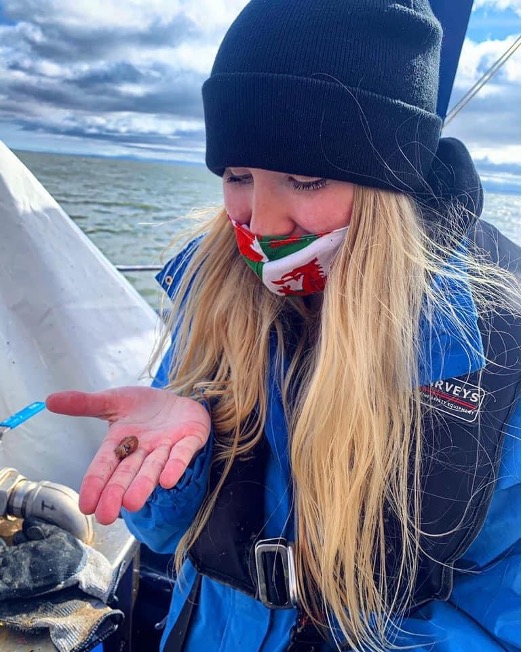
My name is Lowri O’Neill, a 20 year-old marine biology student studying at Swansea University. Ever since I can remember, I have always been obsessed with the ocean. As a toddler, I would watch Finding Nemo constantly all day, every day and would kick up a fuss if my parents suggested we watch any other film (how they didnt go stir crazy, I honestly dont know…). However, my first real introduction to marine biology came at the age of 15, where we visited MOTE Marine Laboratory and Aquarium on a school trip. Here, I learnt that you could study the ocean as a career and that there was such thing as a ‘shark scientist’ which completley blew my little 15 year-old mind. Ever since, I have been an aspiring marine biologist who dreams of one day being able to hold the incredible title of ‘shark scientist’ – coolest job in the world, in my opinion! Through my degree, I fell in love with the practical side of marine biology and most enjoyed fieldwork and working in the laboratory. With this, I decided to apply for an integrated year in industry as part of my degree, which would allow me to work in the field and gain invaluable experience over the period of a year. After many setbacks as a result of COVID, it was only by chance that I secured a placement with Project Seagrass – now looking back, these setbacks were such a blessing in disguise as my time with Project Seagrass (so far) has been nothing less of incredible. I was to be thrown into the deep end for my first task, and joined the team at the Isle of Wight to assist with some fieldwork, mainly logger retrivals and drone map surveying. This was my first time working around the tides and experiencing the classic sleep schedule of a true marine biologist, including starts as early as 3am! However, early morning calls were rewarded with colourful sunrises above beautiful seagrass meadows – a sight that felt very magical to see (after a strong coffee). Perhaps even more exciting, this trip was to be the first time that I experienced a seagrass meadow in all it’s glory. I left the Isle of Wight feeling extremley inspired and with a burning passion to want to protect the meadows I had just wandered. A perfect start to my internship! During the last three months, I have supported the team across a number of projects across the UK. Assisting with small scale experimental planting trials in the Isle of Wight, processing seagrass nutrient analysis samples in the laboratory and more recently, I have assisted PhD student, Aisling Collins, with collecting blue carbon samples from Loch Craignish in Scotland. Along with supporting these projects, I have also helped with education outreach (creating bilingual resources both in English & Welsh) and social media communications. I am incredibly grateful for the opportunities that Project Seagrass have and continue to offer me, and I am incredibly honoured to be able to assist such a devoted, hardworking, and supportive group of amazing people. I have learnt so much from each individual member of the team and have never felt more inspired to conserve and protect our wonderfully important seagrass ecosystems. Seagrass most definitley does rock!! Cyfiethiad Cymraeg Internio â Project Seagrass Fy enw i yw Lowri O’Neill, myfyriwr bioleg y môr 20 oed sy’n astudio ym Mhrifysgol Abertawe. Byth ers i mi gofio, dwi erioed wedi caru’r môr. Fel plentyn bach, byddwn i’n gwylio ‘Finding Nemo’ yn gyson, trwy’r dydd, bob dydd a byddwn yn pwdu pe bai fy rhieni’n awgrymu ein bod ni’n gwylio unrhyw ffilm arall (sut na aethant yn wallgof, dwi ddim yn gwybod i fod yn onest …). Fodd bynnag, daeth fy nghyflwyniad cyntaf i fioleg y môr yn 15 oed, lle ymwelon ni â Labordy Morol ac Acwariwm MOTE ar drip ysgol. Yma, dysgais y gallech chi astudio’r cefnfor fel gyrfa a bod math beth â ‘gwyddonydd siarc’, rhywbeth doeddwn i ddim yn gallu credu… beth?? Byth ers hynny, rwyf wedi bod yn fiolegydd morol uchelgeisiol sy’n breuddwydio am un diwrnod lle gallaf dal y teitl anhygoel o ‘gwyddonydd siarc’ – y swydd orau yn y byd, yn fy marn i! Trwy fy ngradd, cwympais mewn cariad ag ochr ymarferol bioleg y môr a mwynheais waith maes a gweithio yn y labordy’r fwyaf. Gyda hyn mewn meddwl, penderfynais wneud cais am flwyddyn mewn diwydiant integredig fel rhan o fy ngradd, a fyddai’n caniatáu imi weithio yn y maes a chael profiad amhrisiadwy dros y flwyddyn. Ar ôl llawer o rwystrau o ganlyniad i COVID, dim ond ar hap y sicrheais leoliad gyda Phroject Seagrass – nawr wrth edrych yn ôl, roedd yr anawsterau hyn yn gymaint o fendith mewn cuddwisg gan fod fy amser gyda Phroject Seagrass (hyd yn hyn) wedi bod yn anhygoel ac anghymarus. Cafodd fy nhaflu i’r pen dwfn ar gyfer fy nhasg gyntaf, ac ymunais â’r tîm yn Ynys Wyth i gynorthwyo gyda gwaith maes, yn bennaf adalw cofnodwyr ac arolygu mapiau gyda drôn. Hwn oedd fy amser cyntaf yn gweithio o amgylch y llanw a phrofi’r amserlen gysgu glasurol fiolegydd y môr, gan gynnwys cychwyn mor gynnar â 3am! Fodd bynnag, gwobrwywyd galwadau bore cynnar gyda machlud haul lliwgar uwchben dolydd morwellt hardd – golygfa a oedd yn teimlo’n hudolus iawn i’w gweld (ar ôl coffi cryf). Efallai hyd yn oed yn fwy cyffrous, roedd y daith hon y tro cyntaf i mi weld dôl morwellt yn ei holl ogoniant. Gadewais Ynys Wyth gyda theimlad o ysbrydoliaeth eithafol a chyda angerdd enfawr i eisiau amddiffyn y dolydd roeddwn i newydd grwydro. Dechrau perffaith i’m interniaeth! Yn ystod y tri mis diwethaf, rwyf wedi cefnogi’r tîm ar draws nifer o brosiectau ledled y DU. Gan gynorthwyo gyda threialu plannu arbrofol raddfa fach yn Ynys Wyth, prosesu samplau ‘dadansoddi maetholion’ morwellt yn y labordy ac yn fwy diweddar, rwyf wedi cynorthwyo myfyriwr ôl-raddedig, Aisling Collins,
Lindisfarne National Nature Reserve
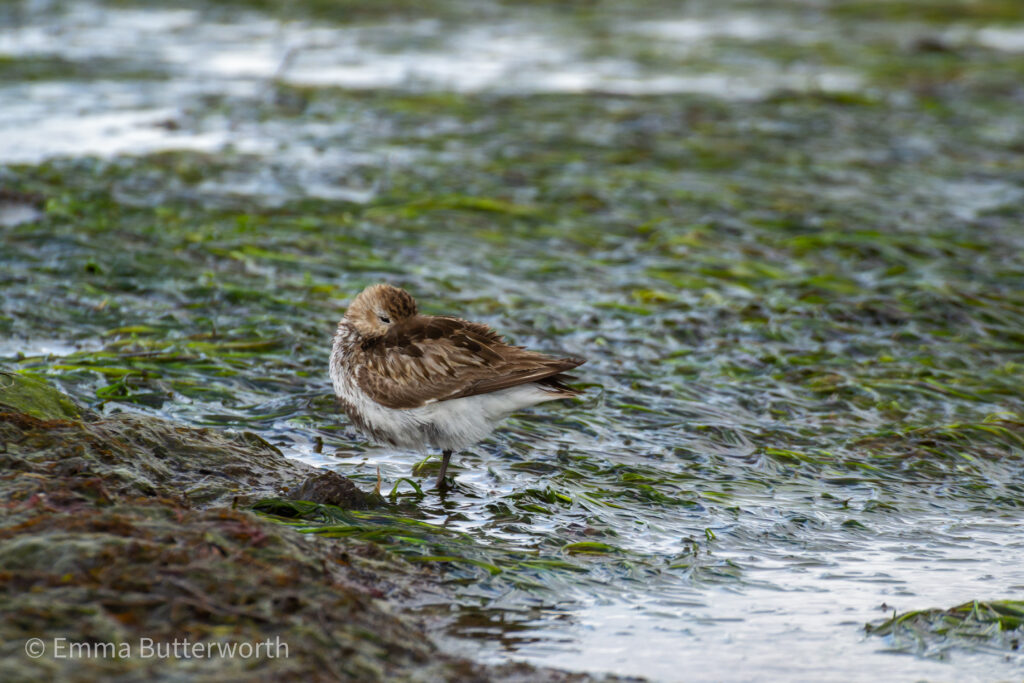
Holy Island. A place with a rich history of monks, Vikings and saints. Nowadays Holy Island, also known as Lindisfarne, is a hotspot for tourists wishing to learn about British heritage or walk along the beautiful coastline. I only learnt just a few days prior to travelling up to Lindisfarne National Nature Reserve (Lindisfarne NNR) that as well as history, the mudflats there are also home to seagrass meadows! This was the reason for my journey from Swansea to the Northumberland, to help collect and transport seagrass seeds from the meadow at Lindisfarne back to Swansea. Our weekend team was led by RJ, with me and three volunteers joining to lend a hand which was only made possible through support from BIAZA. Before we organised the trip, we needed consent from Natural England to collect the seeds. The Lindisfarne NNR is a site of Special Scientific Interest (SSSI) and so permissions are always sought when working in these environments (to ensure the best management of these places). However, since we are working in partnership with Lindisfarne NNR on this project, obtaining the consents for this work was straightforward. Thursday came about and we met at the Island late morning. Our timings were completely reliant on the tides as the only way to access the island and mudflats is to go when the tide is low. This gave us a window of a few hours to get our work done out on the meadow. The first task of the weekend was to collect 600 spathes (the parts of the seagrass that contain the seeds). The hours spent kneeling to pick those spathes were very peaceful. The only sounds were the wind whistling and the eerie wail of what must have been hundreds of seals hauled out on the sand across the flats. The strong gusts carried the sounds making it almost haunting. Similar to the day before, Friday involved more seed collection but this time we needed to do some more data collection. Quadrats were used to assess the condition of the meadow. This is important as this is the first time we have been able to collect seeds from this area. As well as collecting data, spending time on the meadow was a good opportunity for taking photos. There were dozens of wading birds, from curlews to dunlins, all using the seagrass meadow as a feeding ground. It was great to see so many species all gathered in one place!! After a final day of seed picking and some video shooting for social media, RJ showed me some of the coastal towns in the area. It was my first time in Northumberland and South East Scotland, so it was great to the see the beautiful towns like Dunbar and North Berwick. These are the communities which we will be working with if Project Seagrass can expand its restoration sites to Scotland, so it was wonderful to see them first hand. Overall is was a very successful weekend as we collected our goal of 600 spathes, the data needed, and footage. I also completed my personal goals of seeing interesting birds, doing photography, and learning about this incredible area of Britain!
A fortnight in North Wales
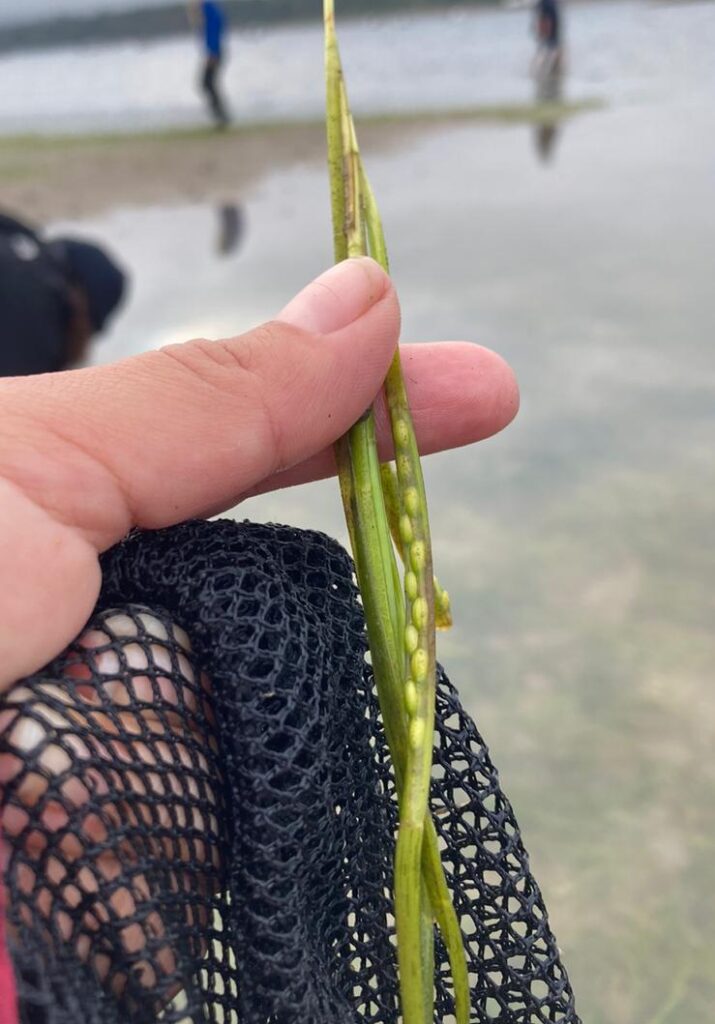
My name is Emma and I am a marine biology undergraduate student at Swansea University. This summer I started a year long internship placement with Project Seagrass as part of my degree scheme and boy did I jump in at the deep end! My first experience was to be joining the team and volunteers in North Wales for a fortnight of picking seagrass seeds, and so on Saturday 1st August Evie and I made the 5 hour drive from Swansea to the Llŷn a’r Sarnau Special Area of Conservation. After settling in, it was early to bed as work was to begin at 2am to catch the first low tide of the trip. The first night of a week of very strange sleep patterns! Meeting in the dark at Porthdinllaen beach, armed with headtorches and mesh bags, Dr Unsworth gave a quick briefing to make sure we were all up to speed with the nights task. To collect mature seeds we’d need to find seagrass spathes, which could be identified by their lime green or yellowish colouration. Despite it being the middle of the night, the light from our headtorches made finding spathes very easy. As well as spotting the all-important seagrass spathes, wading on the meadow at night gave a unique opportunity for spotting interesting creatures. The highlight of the night-time pickings was seeing tiny little cuttlefish, with such bright colours! Returning to Porthdinllaen during the day, we donned our wetsuits and weight belts ready to enter the water. With the sun shining (most of the time!) we entered the water, picking yet more seeds. This time we would dive, or reach, down to pick the spathes which were up to a few meters beneath the surface. This technique allowed us see the seagrass meadow in its own world, from beneath the waves. It was truly a stunning, life-filled landscape with pipefish, spider crabs, sticklebacks, wrasses and more! We continued this cycle for the first week, wading at night and snorkelling in the day. This changed during the second week, when the volunteers left and the dive gear came out. Those in the team qualified to dive would kit up and dive around low tide. Being able to stay down at the seagrass’s level rather than having to constantly duck dive down meant that far more spathes could be picked with much less effort. After two weeks of wading, snorkelling, and diving, we had amassed a very good number of spathes! It was a very successful trip, and our final task was to empty the huge blue tank and pack up all the gear into the van. This was no mean feat but in about half a day we were done, and so ended my first two weeks working with Project Seagrass!
New life and new hope

Ah, the long awaited bank holiday weekend is almost here, but this time the circumstances are more than a little unusual. Instead of heading to the beach we will be staying at home, not just to look after ourselves but to support our NHS and it’s amazing staff. Easter is a time to celebrate Spring, it’s the time of year when everything in nature is changing and promising new life and new hope. However you celebrate, I think we can all agree it’s a pretty eggciting time! One of the iconic images we associate with Spring are eggs! Eggs, wonderful aren’t they? From hen eggs to chocolate eggs you’d think you’ve seen it all, well what about cuttlefish eggs? Ooo want to know more? Eggcellent! Why don’t you check out this 2016 blog post from our Director Ben, I think you’ll agree it’s worth getting eggcited about! Eve
Oceans Festival 2019
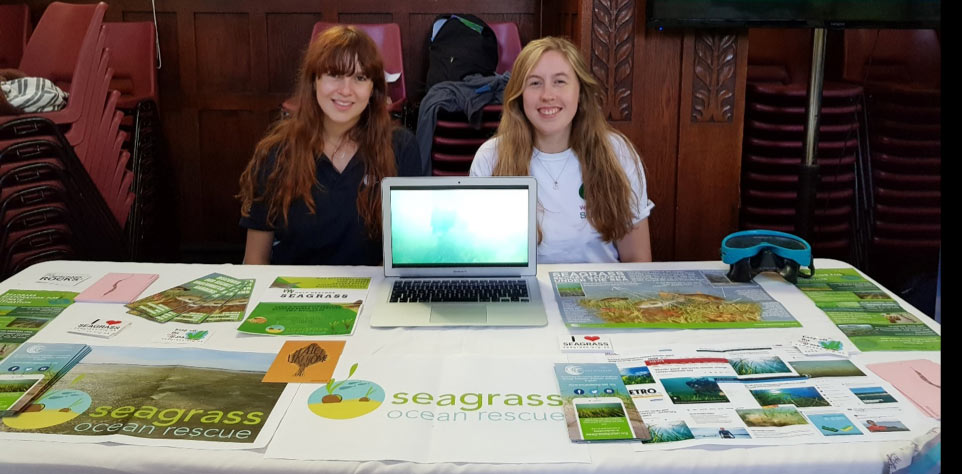
Oceans Festival was a day to celebrate work being carried out by scientists, educators, volunteers, artists and many more. There was a variety of stands all sharing the same passion for our oceans. With stalls selling sustainable and plastic free items to beautiful artwork of marine mammals as well as yummy vegan food there was something for everyone. There was a variety of stands all sharing the same passion for our oceans. Matt Brierley started the talks off on his new documentary he has been filming on the shark trade in the UK. It was shocking to find out that spiny dogfish which is critically endangered in the northern Atlantic is majority eaten in our fish and chip shops. These female sharks take 12 years to reach sexual maturity and has one of the longest gestation periods of any vertebrate, up to 2 years! Aside from this, illegal species are being brought into London fish markets, such as a juvenile scalloped hammerhead which is critically endangered and listed on CITES. It was terrifying to find out this happening in the UK. To move forward Matt wants “shark” to be labelled in fish and chips shops rather than the many other names it is given. This will make people more aware on what they are actually eating! A shocking fact I learnt at Scotland basking shark talk was that these sharks are consuming 440g of plastic every hour! There was a huge range of talks given from Lizzie Daly, Blue Ventures, Manta Trust and the Wave Project. This charity helps children who have had difficulties in their life and teaches them how to surf as a form of therapy. This massively helps build their confidence people, even changes the lives of these young people. This charity emphases how our oceans are used for a huge variety of purposes. To end the talks Andy Reid from Fins attached shared his involved with the charity and shared the legacy of Rob Stewart. This really touched me as when I was so inspired by Rob and his team growing up and how motivated he was to do everything he possibly can to save sharks and raise awareness of what is happening in the shark finning industry. His legacy carries on and with a new research vessel called Sharkwater which is traveling the globe to collect valuable marine data. On the stand it was great to hear such positive feedback from people about the project and to educate people about the importance of these incredible underwater plants. As well as seeing people wanting to get involved with the work being carried out by Project Seagrass. Overall there was a great sense of ocean optimism that spread across the festival, with people who are making a difference and to save our blue planet. Hopefully there will be more brilliant events like these. Thank you Oceans Festival 2019 for having us, and to everyone who volunteered. It was very fulfilling and enjoyable day! Thank you for reading. Issy Inman
Intership Reflections – An introduction to Underwater Gardening!
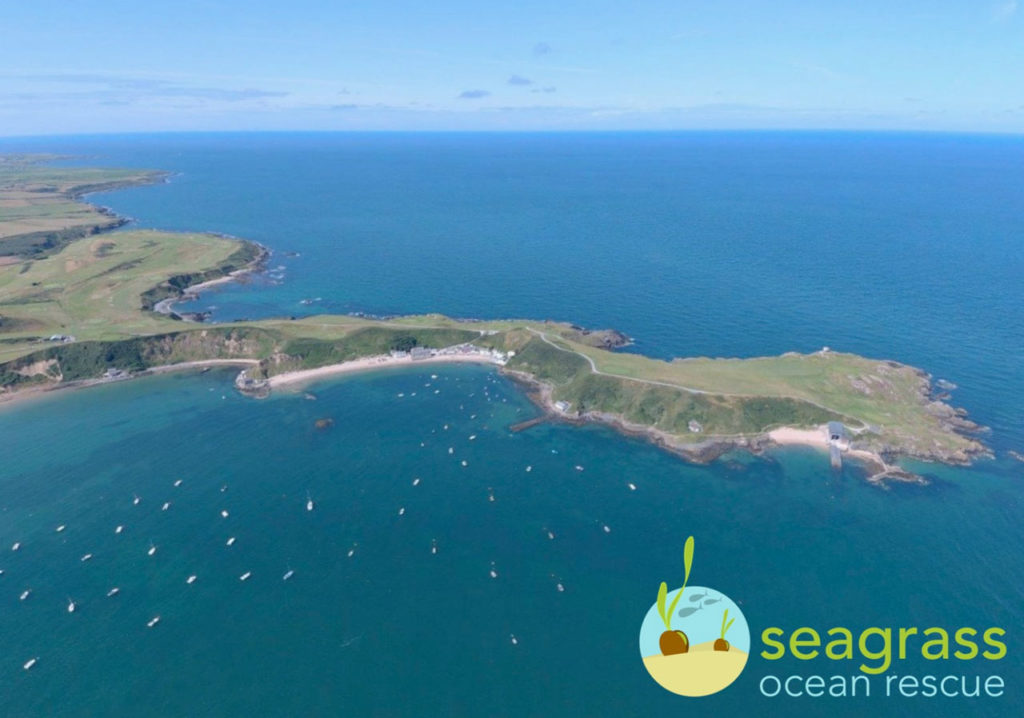
Hello, I am Issy, a new intern at Project Seagrass. I just wanted to share with you a quick update with what I have been involved in so far! My first day started at Porthcawl beach, with two groups of excited primary school children. Here, in small groups, marine animals were built using natural material found along the beach. It was great to see how enthusiastic and engaged the kids were, some who rarely get to go to the beach. Inspiring the next generation is a vital for both raising awareness of the importance of our oceans, and for creating a passion and love for our oceans. After a week of getting settled, I was lucky to go to Falmouth with Evie Furness to start the picking of the seeds for the Seagrass Ocean Rescue project. We were showing a group of volunteer SCUBA divers what the seeds looked like, and how to collect them. It was a very enjoyable experience and I met some lovely people. It was also my first time snorkelling in seagrass meadows, I was taken back on how beautiful the Cornish coast is, and how and clear the water in seagrass meadows can be! The meadows I snorkelled in were huge and it felt like you could get lost in them. Shortly after Cornwall I joined the rest of the team in north Wales where the main picking was being held. Alex and I would go snorkelling collecting the seeds while the rest of the team went scuba diving. We would spend up to an hour and half in the water, I found it was peaceful and very therapeutic collecting the seeds, it was like being an underwater gardener! As seagrass being a nursey ground there was a range of fish species present including a greater pipefish. During our time in North Wales we were lucky to have teams from our partners Sky Ocean Rescue and WWF come and film the work being carried out here. This was a thrilling experience, and nice to see a buzz about the project from the public. It is vital to raise awareness of seagrass and its importance to the ecosystem as part of the issue conservation has not gone ahead is the lack of knowledge and understanding to the general public. Sky Ocean Rescue and WWF have been amazing at shinning the spotlight on seagrass. This will hopefully encourage more projects like these to go ahead in the future. Immediately after our trip to north Wales, Alex and I went back to Falmouth for a shore dive so more volunteer divers could get involved with the picking. There was also a BBQ to raise money DDRC Health in Plymouth as well as baby lobsters being released into the seagrass meadows from national lobster hatchery. It was great to see so many people involved and from a variety of ages, all willing to give up there Sunday afternoons to help with this project. Finally, another trip back to North wales for Seagrass-Watch. This is a scheme to monitor meadows across the globe to check the health and early signs for any degradation. Waking up at 3am in order to work with the low tide is fairly typical start time for a marine biologist, and watching the sunrise was magical – completely worth the early start! Over the couple of months it has been nonstop, I have met so many wonderful people and I have loved getting a hands on experience with the field work on such an important project. It has opened my eyes to how these restoration projects across the globe requires so much effort and hard work from many volunteers and workers but how fulfilling and worthwhile it is. I am looking forward to what the rest of the year has in store. I would like to give and big thank you to everyone who has helped with this project so far. Thank you for reading. Issy
Isadora Sinha on her Project Seagrass Experience
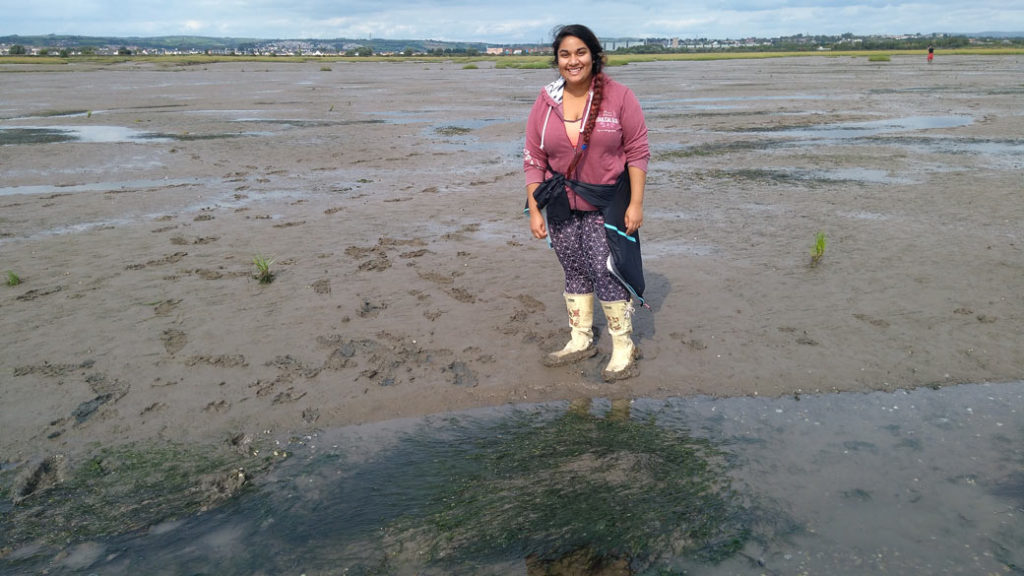
To give you a bit of an introduction, I am a Cardiff University Genetics (BSc) student going into my final year of my degree and have joined Project Seagrass for a Cardiff University Research Opportunities Programme (CUROP) summer research placement, at their offices in the Sustainable Places Research Institute. I stumbled upon Project Seagrass rather unexpectedly and had no idea what it was all about. Upon reading further into what seagrass is and the work Project Seagrass does, I was very keen on joining the team to learn more and take part. The Project Seagrass team are the nicest people I have worked with and maintain a lovely work environment where research and collaboration can flourish. When I first heard of the organisation, I did not know what seagrass was nor how important it is. Seagrasses are flowering plants that live in marine environments off the coast in shallow water. I know many people, including myself before this project, do not know the difference between seaweed and seagrass. Seagrass has roots, stems, leaves and flowers just like terrestrial plants do and holds some very important roles. I have learnt that seagrass is vital for: food security for coastal communities; fisheries; increasing water quality, reducing atmospheric carbon dioxide and as a food source for plant eaters like sea turtles! That is a long list of important roles which I had no clue about. This made me realise how seagrass is absent from public awareness. Rainforests get lots of publicity, yet seagrass, that can sequester carbon ~35 times more efficiently, somehow lacks it. Hopefully, in time that will change as more people realise that public awareness needs to be raised. Unfortunately due to several factors, seagrass is declining (if you want to learn about why, go to the Why Seagrass). This is catastrophic given the amount seagrass does for the marine environment as well as for us. Project Seagrass aims to push conversation efforts, educate the public and collect data on seagrass to the goal of restoring seagrass meadows to their former health and abundance. I am from a rather specialised degree, however, I found I quickly adapted to research here and am greatly enjoying it. Project Seagrass runs multidisciplinary projects which is why the collaborations are so exciting and surprising! My work itself is has been a mixed bag of literature reviews, data analysis, application development and learning lots about seagrass and citizen science. Seagrass is not sufficiently mapped due to the dynamic and vast nature of seagrass; it shrinks and grows with changing seasons and conditions. Plus, it is spread globally and is under water so it is often hard for scientists to fully monitor. This is where the use of citizen science could be a game changer. Citizen science is the participation of citizens in the collection of (usually ecological) data in collaboration with scientists. Citizen science is fantastic as it has the potential to increase data points by thousands compared to scientists collecting data alone, and it means more area is covered too. This Earth is shared by all of us so if people are passionate about conservation and want to help, citizen science is ideal. It gives individuals the chance to make a meaningful contribution to scientific knowledge as well as protect what they care about. In line with using citizen science to save seagrass, Project Seagrass has created a mobile application called SeagrassSpotter which is available on iOS and Android. SeagrassSpotter data is used to map seagrass. This is done as users report sightings of seagrass, whether it be while going kayaking or walking their dog on the beach. The report is logged in the form of a geographically tagged photo of the seagrass and is put publically on the SeagrassSpotter database so everyone can view it. Mapping seagrass is important so Project Seagrass has data that enables them to reinforce conservation action, petition for needed conservation policies, as well as make targeted actions in specific areas where more research is needed. This data would also help identify areas where seagrass has been declining and where it is still flourishing. My project concentrates on analysis of the demographics of current SeagrassSpotter users, which has never been investigated before. The demographics of users are of particular importance as we want to ensure that SeagrassSpotter is used by citizens of all ages and professions, not solely by researchers. If it turns out, participants are mainly researchers, then we need to think about how best to make SeagrassSpotter accessible and known to the wider public. If the results show that there are mainly young users, we need to find ways to make SeagrassSpotter more user friendly for the older generations. After analysing the results, I will generate applicable suggestions and improvements on how to increase citizen participation as well as ideas for technical application improvements. The demographic data is being obtained by means of a survey which was made in collaboration with, master’s student, Oliver Dalby. The survey has citizen participation motivation questions as the main portion which is what Oliver’s project focusses on. The demographic questions at the end of the survey is how the data I am analysing for my project is collected. I hope that my work will contribute to making SeagrassSpotter more widely used as well as add to the understanding the user-base of the application and what effect that has on data collection. This in turn would ideally lead to more users of the application, resulting in more data and more mapping of seagrass. The objective is to use this information to push for change to protect seagrass, subsequently saving wildlife and protecting communities. My time working on this project has opened my eyes to the importance of seagrass and its conservation. I have also learned new transferable skills as well as gained specific knowledge of citizen science. I can see the need for geneticists in seagrass research so who knows what could come of the future. I am happy to be here now and to
Seagrass citizen science: investigations into a potential seagrass saviour

A guest blogger? But why should I bother reading what he has to say? Well here’s a bit about me…. Originally hailing from Melton Mowbray, a small town in the middle of England known solely for producing pork pies and stilton cheese, my initial foray into marine science began with any other child’s obsession with the beach. My parents often remind me that after hours of poking around in rockpools and catching crabs I would throw tantrums when it was time to leave the coast and return to my landlocked home. As I became older and words like career and jobs became ever more prevalent in my life, I began searching for the holy grail of adult life, a job which I genuinely enjoyed. This search led me to undertake a Bachelor’s degree in Coastal Marine Biology in the now non-existent Scarborough Campus of the University of Hull; I should clarify that my class was the last year to graduate from that tiny seaside town before the satellite campus shut down. It was during my time as an undergraduate researching in the Aegean Sea that I first encountered seagrass ecosystems and immediately fell in love. Seagrasses are the only true marine angiosperm (flowing plants) and have been described by Professor Carlos Duarte (a famous seagrass scientist) as ugly duckling ecosystems. After returning from that career changing trip all my subsequent assessments were targeted towards seagrasses as I endeavoured to learn all I could about their function, ecology and reproduction. A room with a view… daily scenery when completing Aegean seagrass surveys. This obsession permeated through to my Master’s degree at the University of York in Marine Environmental Management where my supervisor shared a passion for these underappreciated ecosystems; it seemed fate had brought two seagrass nerds together at last. As I continued through the MSc with a specific focus on seagrasses when possible there came a time where I had to find an external placement partner to complete my second thesis with. Being still constrained firmly to the student financial situation I did not have the prospect of travelling to far flung places as some of my peers. However, this hardly mattered as my first choice was to work with the only active group of seagrass researchers in the UK, Project Seagrass! After finalising the logistics of the project and “upping sticks” to Cardiff in mid-July I now right this blog post sat at a desk in Project Seagrass HQ nestled in a surprisingly sunny Cardiff. But that’s enough about me, let’s talk seagrass citizen science! The project I am completing investigates the motivations, benefits, barriers and changes in knowledge associated with taking part in seagrass citizen science projects, specifically SeagrassSpotter and Seagrass-Watch (follow the links if you want to learn more about these projects). More broadly the project sets out to discover who is taking part, why they take part and when they take part. The project itself is being co-managed by myself and Isadora Sinha of Cardiff University who is heading up the demographics (the who) associated with the project. Throughout the project we utilised an online questionnaire which has been disseminated to current users of SeagrassSpotter, Seagrass Watch, and various seagrass-based email and social media groups (yes seagrass Facebook groups exist, if you’re interested you should join one). Given that citizen science, the participation of non-scientists in scientific research, has been labelled as a source of large data sets across varied space and time, seagrass citizen science has the potential to alleviate some of the primary threats these ecosystems face. Talking all things seagrass citizen science at a workshop organised by Cardiff University. Seagrasses are thought to be declining at around 7% a year, with declines primarily due to changes in water quality and increases in suspended sediments which reduce the ability of the plant to photosynthesise by blocking available sunlight. Additionally, researchers have little idea of local spatial coverages of seagrasses due in no short part to a chronic lack of public awareness of their existence; a concept which doesn’t apply to more charismatic ecosystems such as coral reefs. This decline represents not only the loss of a beautiful marine habitat (see the photo below if you don’t believe me) but also the services these ecosystems provide. Seagrasses are present on the coastal fringes of almost all continents worldwide where their presence promotes high primary and fisheries productivity, in turn supporting food security worldwide. You know the cod that forms an integral part of your chippy tea? Well it probably spent a good part of its juvenile years living in and around seagrass meadows. Seagrasses also add 3D structure to muddy bottoms, enhancing sediment capture which stabilises coastlines against erosion and acts to trap carbon dioxide helping to combat climate change. It is therefore hoped that by better understanding why people take part in seagrass citizen science we can reduce barriers to participation and increase public awareness and conservation of these crucial ecosystems. The project also represents the first time these topics have been studied in a seagrass specific context so will provide much needed insight into the finer state of seagrass citizen science. For a global review of seagrass citizen science see this article led by Project Seagrass Director Benjamin Jones (sorry, it’s not open access). At the time of writing the survey has been sent to over 1000 people and has been completed around 60 times. This may not seem like a worthwhile return, but such a small number of responses is common among online surveys. Results from the survey are being collated currently and will be prepared ready for my MSc thesis submission in early September. So, watch this space for seagrass updates! Together we can promote conservation and raise awareness of seagrasses to help this ugly duckling become beautiful swan.
Talking about Plastic Pollution during EU Green Week

Kayaking on the Isle of Skye’s lochs you feel as though you’re a million miles from civilisation; back to basics with wildlife flitting about you and crystal clear waters to peer into. There’s no rumble in your ear of background traffic noise or aeroplanes going overhead. Just you, your paddling buddy and the creatures that decide to make themselves known. Feeling completely remote on Loch Eishort. Being somewhere that appeared so untouched by man is a luxury hardly ever come across in the modern day, but the illusion was burst as we stopped at a beach at the top of Loch Eishort. The place was awash with tropical blue – bright blue nets and ropes, tubs and wrappers. A sea of rubbish. Mixed in were huge buoys washed up from the mussel farm across the loch. You can’t help but wonder why the farmer doesn’t make the less than five-minute boat ride across the loch to retrieve them, rather than splashing out on new ones? Doesn’t he / she worry for the health of the mussels with that much rubbish just the other side? Mussels are filter feeders, taking in any particles in the water, including degrading plastic. A glimpse of the rubbish at the top of Loch Eishort. But it’s not just the top of Loch Eishort where we were shocked. Camasunary is a bay on the Isle of Skye only accessible by boat or walking a few kilometres over a rocky track. Reaching it you expect to be isolated from the world, but instead we were greeted with all of man’s rubbish. (On a more positive note, we did find some seagrass washed up in with the rubbish, so hopefully there’s a healthy bed close by!). An uninhabited island. It makes stories such as Henderson Island, one of the world’s most remote islands, having been found to have nearly 18 tonnes of plastic weighing it down, sadly, less shocking. If we can leave this much mess in areas where we can get to, then there’s no surprise that it’s spreading to places where humans should never be. Our way of thinking needs to change. Plastics are not a onetime thing, we need to reduce the amount we use and reuse everything else. The plastic bag charge was one small step in the right direction, but we need a lot more. Choose veg without tonnes of wrapping, try to avoid one use coffee cups, retrieve that buoy instead of buying a new one; small changes will add up. Let’s try to save those last few untouched havens. Thanks for reading! Evie

